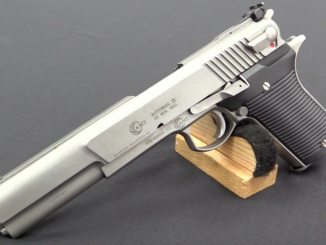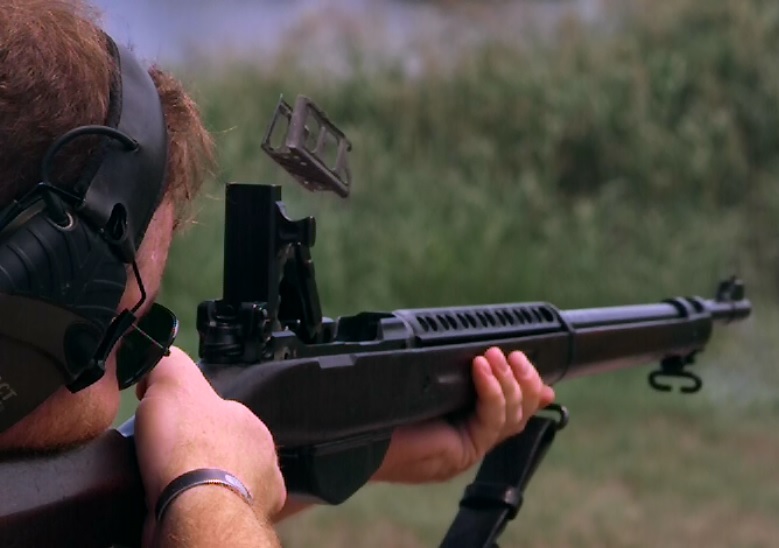The Warner Arms Company was formed in (or around) 1911 to import and sell Schwarzlose 1908 blow forward pistols in the United States. It was run by Franklin Warner, who also operated a sporting goods store (Kirtland Sporting Goods) in New York, and thus had a ready retail outlet for imported pistols. The 1908 Schwarzlose did not prove to be a particularly successful pistol, however, and production was shortly ended. When it did, Warner bought up the remaining parts and tooling, with plans to restart production in the US. This appears to have not been a success though, and in 1914 a new pistol was introduced by Warner.
This new pistol was the Warner Infallible, designed by Andrew Fyrberg – a little recognized designer who sold patents to Iver Johnson, CS Shattuck, and Harrington & Richardson among others. The Infallible was a relatively large and awkward .32ACP blowback pistol, and never did sell very well. In 1917 Warner merger his company with Davis & Sons, a shotgun manufacturer. They would produce Infallible pistols until about 1921, and the last stock appears to have finally sold out by 1924.
There are two main variations on the Infallible, differing primarily in the disassembly procedure. The first guns used an easily unlocked lever to connect the bolt to the dual recoil springs. This led to concern that the lever could be inadvertently unlocked while firing, which would then leave only a small bolt stop to prevent the bolt from ejecting out the back of the frame into the shooter’s face. Whether this was a real threat or not, it was certainly perceived to be, as the second variation would replace the disassembly lever with a solid pin that was definitely not going to come out accidentally.
Only about 7600 Infallibles were made, as they were completely eclipsed by the Colt 1903, Remington Model 51, and Savage automatic pistols. Unfortunately, high condition Infallibles are very rare today, but they were originally finished with a completely case hardened frame and look very cool.
Thanks to Ed Buffaloe for the research he has put into these guns, which made this video possible!




“Infallible was a relatively large and awkward .32ACP blowback pistol, and never did sell very well”
Blow-back require some mass of moving parts to work as intended, for whatever reason (patent infringement? marketing attempt as unique weapon?) designer put that mass behind, rather than around, which indeed give this weapon distinctive looks, but also make it bigger than its needs to be and mean that simply putting sights on slide was not possible.
Putting sight on “rail” reminded me about one early automatic pistol – Clément 1903, see photos here: https://www.rockislandauction.com/detail/64/1501/clement-chas-pocket-pistol
“imported pistols”
It seems that attempts of import/license-production in early 20th century of European automatic pistol in United States failed, beyond Schwarzlose 1908, there were for example:
Phoenix Arms producing .25 automatic pistol, which in its European version is known as MELIOR OLD MODEL: http://unblinkingeye.com/Guns/Melior1911/melior1911.html
S&W tried with Model 1913 automatic pistol (for unique .35 cartridge), which was derived from CLÉMENT automatic pistol (also using low popular 5mm Clément cartridge, but later switched to .25 Auto)
H&R license-produce Webley automatic pistol, in two sizes: for .25 Auto and for .32 Auto
Neither of these designs gained wide popularity.
I’m wondering if the disassembly change was motivated more by safety concerns or because a pin was simply cheaper than the rotating lever. I doubt that the typical purchaser of such a pistol was savvy enough to appreciate the potential danger.
Until he gets the bolt in his teeth. Would you like a hard piece of steel coming at your face at about fast ball speed from arm’s length?
Even with the Broomhandle Mauser, would it have gained more early sales without high velocity steel coming at the shooter’s face?
“Broomhandle Mauser”
I though, that they could advertise it as IT IS MAUSER with good effect, as Mauser Werke were at that time (1890s-1900s) were respected in Europe, if I am not mistaken.
How was Warner Arms Co. tread by potential user in 1910s? It was negative or positive or neutral?
I own one of these. The frame is one big iron casting, quite heavy, and if it is case-hardened, they hid that quite well. The unlocking recoil springs make it a breeze to cock.
I bought it because it is so ugly. It’s fitting that RIA have chosen to group it with a Dreyse – you can’t find two uglier handguns.
With the Mauser name, a glowing testimonial from Winston Churchill and a pretty solid design that persisted for decades things weren’t bad for the broomhandle, but we had to wait for the Luger to come along for a military contract. New technology faces an uphill battle, wide acceptance of polymer framed pistols took some time. The tolerances on the Mauser’s bolt aren’t real tight, and at least some people must have asked whether it would break. Maybe they were just revolver curmudgeons and any excuse was good enough.
Ross rifles were never popular after their problems with bolts, and a fix was instituted. So there had to be at least awareness of a remote or even imagined problem with the Warner. The Warner name wasn’t solid like Mauser’s, they simply didn’t sell many guns.
Meant as reply to Daweo, my browser updated with a glitch, or I took to long to type, or who knows?
If you reload the page for any reason, the comment system will sometimes forget the comment you are replying to and adds your comment to the end of the comment section.
Euroweasel, thanks, I will keep that in mind.
I have an old single shot 12 gauge break action with a pretty twist steel barrel that was made by Andrew Fyrberg & Sons. It was sold in the Sears catalog bock in the early teens and single digits. It is virtually worthless, can’t be shot with modern 12g shells, but it is very nice looking. It is called “World’s Champion Ejector” — perhaps some more wishful naming????
“some more wishful naming”
Another such example might be Spanish TITANIC 6,35 mm Browning (.25 Auto) automatic pistol: http://www.littlegun.be/arme%20belge/copie%20belge/a%20copies%20belges%20retolaza%20gb.htm
Andrew Fyrberg, though this pistol does not reflect his genius, is the inventor of today’s most used “Transfer Bar” revolver safety system, . Related patent:https://docs.google.com/viewer?url=patentimages.storage.googleapis.com/pdfs/US566393.pdf
This pistol’s patent; https://docs.google.com/viewer?url=patentimages.storage.googleapis.com/pdfs/US1105416.pdf
If noticed, over all design seems very crude for the years it introduced. Even the “Escaping disconnector” looks having restriction for sound use. Appearently, Mr Andrew could not make a positive transmission from revolver to auto loading genres.
The Browning/Colt patents were VERY broad.
Mostly true. Not only Colt/Browning, but Savage, Smith Wesson/Clement, European Companies which registered their rights in The USPTO. Like Mauser, Bergmann. Schwarzlose, Mannlicher… And this is the embodiment of remaining rights.
Few have a problem with anglicizing foreign names, particularly unusual ones.
I also know we are “over” fretting this or that foreign pronounciation.
If I may, however, Andrew Fyrberg was born in Sweden in approx. 1853. Likely as not he would have been “Anders” (patronymic) Fyrberg, and when he immigrated in the 1870s, his name was anglicized to “Andrew Fyrberg.”
Swedish is notoriously difficult to pronounce, but the last name–put on your “Swedish chef” hat!–is pronounced “Fewerbear” or closer, perhaps,
Ff-yew-r-bear-yeh. “FYOU-r-bare-yuh.” A bit like that.
Interesting episode as always! “Tack!”
You are essentially correct. Swedish is not my first language, but I can pronounce it pretty well. I might add that it’s in general not that difficult for anyone who is accustomed to “continental” vowel values, which are fairly similar in most continental European languages. English is different, because its spelling dates mostly back to the so called Middle English, but actual pronounciation of vowels has changed (or shifted) greatly.
Now, the word “berg” in Swedish is admittedly somewhat difficult, because the “e” does not have a continental value and “g” is semi-silent and not pronounced like a consonant. This is nothing compared to Danish, though, which has dropped much more word endings from pronounciation (a bit like French), so that people who know Swedish can understand written Danish quite well, but only bits and pieces of what a Danish person is saying.
Troublesome to the native English speaker are the different consonant and vowel combinations. In English we have a, e, i, o, u and sometimes y. In Swedish one has a, e, i, o, u, always y, and also å, ä, and ö. Each with a “long” and a “short” sound…
And with a, o, u, å as “hard” vowels and e, i, y, ä, ö as soft vowels.
So “Karl” is “Carl” but “köttbulle” is “chewtbooluh” más o menos.
“Seven” is “sju” pronounced something like “Hhfyoo” or “phew” but subtly still kinda different.
G can be a “g” or, as you say, a semi-silent “y.” “mig”=”may”-me.
K can be a “K” or a “Ch”. sk is straightforward in “skål!” but then becomes “sh” in words like “sked”=sheed=spoon. Sch, Sj, Skj all “sh” as in Sjö or “lake” skjuta=a cognate of the English “shoot.” And then there’s the other “Ch” like “kjol” skirt and “tjock” thick…
As for Danish, my limited understanding is that there was a specific desert that would asked by members of the Resistance in WWII as a password, because no non-Dane would ever be able to pronounce it, and German infiltrators would be discovered.
there is the terrible 1937 use of the Spanish word for “parsley,” namely “perejil” that would be asked by Dominicans of blacks to determine if they were compatriots or Haitians. Haitians found the word impossible to pronounce, and anyone who couldn’t would get the sharp edge of a machete under Rafael Leonidas Trujillo’s goons.
It’s got that “pug dog” ugly charm, for sure. So with the economy castings, this was targeting the lower financial strata as a defense gun? A jennings/bryco/hipoint from a century before?
“economy”
How much it cost in 1914? How it does compare to Colt 1903 Pocket Hammerless, Savage 1907 or H&R 32 self-loader?
If a U.S. .32 it must be, make mine a Savage “ten shots quick” or a svelte Colt 1903 pocket, please!
I have both the 2nd type Warner and the Clement. Both look a little on the weird side but are a lot of fun to shoot and turn heads at the range. Guys line up just to take a couple of shots with them. I lot has been written about “how dangerous” the Warner is to shoot because of the way it is held together. I have had absolutely zero problems with the pin staying in place making sure it is fully inserted after field stripping and cleaning. I have looked over the 1st type with the lever and see where that could pose a problem IF you were not paying attention when reassembling and not paying attention to make sure the lever is turned into the locked position.
Hi, I have just bought one and wanted to know if you can help me figure out an issue. I pulled the slide back and it will not return into the battery (it will stop 1 inch from going in). it seems everything else works. I can not find any info about this. I tried several ways but i am sure i am doing something wrong.